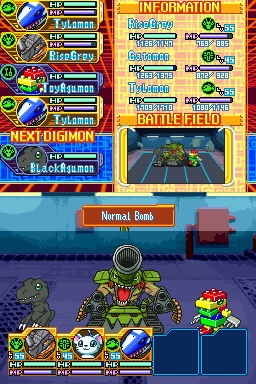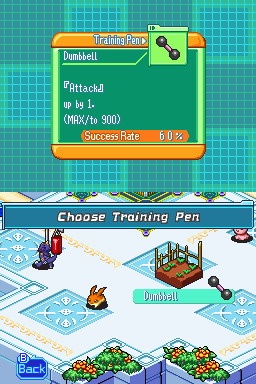There's an old saying that goes, "second verse, same as the first." That just about sums up Digimon World: Dawn and Digimon World: Dusk, both for the Nintendo DS. Apart from a few trivial enhancements that make it easier to train your virtual monsters and challenge your friends to wireless duels, the two versions of this so-called new game really don't offer much above the previous Digimon World that was released the year before. Once again, diehard Digimon fans will probably be able to forgive the game's phoned-in nature, while those not totally enamored with the franchise will probably shake their head at this plodding, half-hearted take on the monster battle genre.
Like Pokémon, as well as all the other games of its ilk, Digimon World is a story-driven dungeon crawler where you set out to capture and raise as many digital monsters, or Digimon, as possible. There's nothing particularly inspiring about the story. It's merely a hackneyed tale that involves two rival factions joining forces to stop a mysterious villain from taking over the world. Visiting the quest counter in the main city will send you out on a fetch quest, which, in turn, will reward you with another ridiculously small piece of the story. Being an errand boy for 15 to 20 hours is terribly boring, as you can imagine. Thankfully, the story is just a means to an end--the excuse to send you to all of the game's different virtual environments so you can skirmish with wild Digimon and add them to your collection of fighting monsters.

Each version of the game tells the same basic story, but they each have their own dungeons and a couple dozen Digimon that the other version lacks. If your favorite Digimon fall into the dragon, aqua, bird, or holy categories, you'll want to pick up the Dawn version. The Dusk version, meanwhile, is geared more toward gathering the beast, machine, organic, and dark species. In total, there are roughly 400 Digimon to collect. To get all 400 into your save data, you'll have to trade and breed your Digimon with other players that own the other version.
Going out on silly quests, fighting the same low-level monsters, and watching the story play out in trickling fashion is all terribly, terribly tedious. However, the reward for your tenacity is the ability to customize and create some truly killer Digimon. The Digimon you collect in the wild will learn new attacks as they gain experience and can be evolved or devolved into other Digimon at certain points. Your Digimon gain different types of experience based on the kinds of monsters you have them fight. When one of your monsters gains enough levels to evolve into a later form, you usually have two or three potential forms to pick from depending on how many different types of wild monsters you've made it a point to fight. Another way to create new Digimon is to mate two Digimon together, which will yield an egg that will eventually hatch a monster sharing the traits of both parents. On top of all that, you can outfit your monsters with swords, armor, and other items that further boost their abilities.
If you played the previous Digimon World, you'll notice a few minor improvements in this new game that are meant to make the process of gaining levels and evolving your Digimon easier. Each area seems specifically set up to help certain types gain experience. Also, when you devolve a monster, it now drops all the way back to level one. That may sound like a negative, but it actually gives you more levels with which to build stats. The biggest change has to do with the Digifarm system. Instead of leaving your Digimon to train at a prebuilt farm, you now get to design your own unique farm by selecting the music you prefer, as well as placing the individual terrain and equipment pieces wherever you like. As before, each piece of terrain and equipment has a specific kind of experience associated with it. For example, by placing a bunch of fire-boosting pieces on your farm, you can turn your Agumon into a Greymon in no time. The overall selection of terrain and equipment has tripled since the first Digimon World. So, even though watching your farm-raised Digimon slowly gain levels on the upper screen while you go about your business on the lower screen still feels very much like watching paint dry, at least you now have greater control over the way your farm looks and how it's set up.
The battle system is pretty fun, even if it hasn't changed one bit from the previous game. Battles are still turn-based and involve three Digimon on each side. When it's your turn to attack, you pick one of your monster's attacks from a list, select the target, and then watch the attack happen. Turns go back and forth until one side's team is defeated. Traits, such as dragon, beast, dark, and holy, come into play as strengths or weaknesses. You also have to take formation into account. On offense, some attacks affect certain positions on the field but not others. On defense, you have to decide whether to situate your monsters side by side to gain support bonuses or to split them up to prevent your opponent from smacking you with group attacks.

Later dungeons and CPU opponents put up a strong challenge. But between the plodding story and the overall predictability of the CPU, you really need to set up battles against other human beings to enjoy the game. For the first Digimon World, that meant local "same room" matchups only. Dawn and Dusk up the ante by allowing players to duel online through Nintendo's Wi-Fi Connect service. You can't just seek out random opponents, which is kind of weak, but it's not too difficult to swap friend codes and arrange battles over e-mail or your favorite online forum. Because the battles are turn-based, you won't notice any problems with lag or stalling. In fact, fighting a real person feels just like facing off against the CPU, except without the mind-numbing predictability. You can also breed your Digimon with your friends or random people that happen to be online. That will help you acquire the majority of Digimon that aren't in the specific version you're playing. Some of them, though, need to be acquired through straight-up trades, which, for some crazy reason, still can't be consummated online.
The quality of the presentation lacks any kind of heart or soul, but it gets the job done. The isometric 2D environments and tiny characters in the quest view look generic. They're also about as detailed and colorful as the stuff you'd see in every role-playing-game put out for the Game Boy Advance a few years ago. The monsters in the battle view are pretty huge, at least, while their attacks exhibit a wide variety of nifty visual effects for such things as flames, poison clouds, ice crystals, and so on. It's also nice that the game makes use of the upper screen to display helpful status information during the fight. The sound effects are just a bunch of generic slashes, elemental sounds, and growls. However, the music is actually very dramatic and beautifully orchestrated.
Because of the plodding story and modest presentation, this probably isn't a game you should buy if you're not a diehard Digimon fan or won't be able to take advantage of the game's multiplayer features. Conversely, if you are a Digimon fan, as well as know you'll be able to play and trade with other people, you should be able to overlook the game's weaker aspects to get your money's worth.